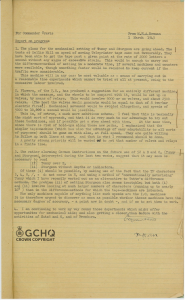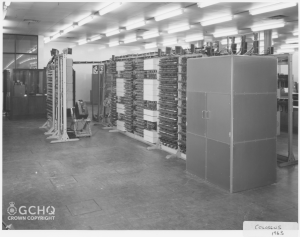GCHQ, Britain’s cyber intelligence agency, marked the 80th anniversary of the Colossus computer. It published a series of rare photos and documents about the revolutionary machine.
According to GCHQ, the revelations surrounding the machine “shed new light on the genesis and workings of Colossus, which stood over two metres tall and is believed to be the first digital computer in history”, although much of the material about it in the National Archives remains classified.
The History
On January 18, 1944, British engineer Tommy Flowers arrived at Bletchley Park, a secret code breaking facility located about 50 miles north of London. He arrives in a lorry carrying a huge electronic machine that is immediately given the name “Colossus”.
There are claims that Colossus was the first ever digital computer used to crack messages between senior German commanders encrypted with the Lorenz cipher – details that remained secret until 2000.
The big secret until 2000.
Unlike its much more famous counterpart Bombe, designed by Alan Turing and Gordon Welchman and used to crack the Enigma codes, almost everything about Colossus was kept secret for almost six decades.
Although modern computers run on electronic circuits that function as logic gates – these days using tiny silicon semiconductors – in the 1940s, creating logic gates in this way was a pipe dream.
The genius Tommy Flowers

ENIAC and World War II
ENIAC was created in the United States during World War II with the original purpose of calculating ballistic tables for the needs of the US Army. It was constructed in 1945 by Americans John Moakley and J. It was founded in 1945 by John Mockley and John Presper Eckert.
The reasons for keeping the details of the computer secret are not yet known, although it has been suggested that Britain continued to export Lorenz cipher machines abroad until the 1960s. And the reason for this was Colossus’ ability to decrypt Lorenz messages.
“Technological innovation has always been at the heart of what we do at GCHQ and Colossus is a prime example of how our employees keep us at the forefront of new technology – even when we can’t talk about it,” commented Anne Kist-Butler, Director of GCHQ.
The British Cyber Intelligence Agency confirmed that, in part, “because the technology was so effective, its functionality was still in use by GCHQ until the early 1960s”.
‘No detailed user handbook’
In the press release accompanying the new documents, former GCHQ engineer Bill Marshall stated:
“I worked as an engineer on Colossus for a year during the 1960s. I had just signed the Official Secrets Act and knew nothing about GCHQ but was offered ‘interesting work’ which I believed would be dealing with telegrams for a government department.
I was told very little about the machine I was working on — what the machine was actually doing was not for me to know. My job was to repair it as necessary, using just a few circuit diagrams and no detailed user handbook. It wasn’t until much later that I found out that several of the systems and detailed design information were supposedly destroyed at the end of WWII.
I’m very proud to have been involved with Colossus even in just a small way, and we should all be proud of what was achieved in the name of national safety and security,” said Marshall.
After the war, eight of the ten Colossus machines were completely disassembled — although, of course, the engineers involved squirreled away the odd part and circuit diagram.”
The engineer Tony Sale led a rebuild of a working Colossus in the 1990s that was completed in 2007 and is currently housed at the National Museum of Computing at Bletchley Park.
“From a technical perspective, Colossus was an important precursor of the modern electronic digital computer, and many of those who used Colossus at Bletchley Park went on to become important pioneers and leaders of British computing in the decades following the war, often leading the world in their work” said Andrew Herbert, the chairman of trustees at the museum.
The most difficult part is to establish an objective measure of the importance of Colossus, which was used to “decipher critical strategic messages between top German generals, although a letter published by GCHQ links Colossus to “quite disturbing German instructions”.
The Importance of Colossus
By the time the machine was delivered to Bletchley Park, planning for the D-Day landings was already underway, but it is argued that the intercepts Colossus provided were valuable for giving the go-ahead on June 6.
As explained by Chris Shore in his excellent lecture on the device for The Centre for Computing History:
“Being able to launch that invasion in early June was absolutely crucial, and they needed that up-to-date intelligence.
On June the fifth, Eisenhower met with his generals to decide whether to go on June the sixth. As they were meeting, so the story goes — and I believe this story is corroborated — a courier arrived from Bletchley Park, walked into the room, and handed Eisenhower a folded piece of paper.
Eisenhower opened that and read it, and what he read was a message that had been decrypted by Colossus at Bletchley Park just a few hours earlier, from Hitler in Berlin to Rommel, commander of the Nazi forces on the Atlantic wall.
And that message stated Hitler’s categorical belief that yes, there would be an invasion in Normandy, but that it would be a diversion, and that the real invasion would happen five days later in Calais. And that message specifically refused Rommel permission to move his tank divisions from Calais to Normandy to reinforce his defenses.
This was exactly the intelligence that Eisenhower had been waiting for – confirmation that the Nazi command had been completely deceived as to the timing and location of the attack.

Today
“Technological innovation has always been at the center of our work here at GCHQ, and Colossus is a perfect example of how our staff keep us at the forefront of new technology – even when we can’t talk about it. The creativity, ingenuity and dedication shown by Tommy Flowers and his team to keep the country safe were as crucial to GCHQ then as today. I’m thrilled to be celebrating the 80th anniversary of this computer and honoring those who worked on it and then with it”, said Anne Kist-Butler, Director of GCHQ.
Did you know?
Despite using around 2,500 valves and standing at more than two metres tall, Colossus is considered by many to be the birth of modern-day computing and is still thought of today as the first digital computer ever made. Experts who worked on the code-breaking computer went onto to create the Manchester Baby built at the University of Manchester in 1948 – putting Manchester at the centre of a global computing revolution.


 “From a technical perspective, Colossus was an important precursor of the modern electronic digital computer, and many of those who used Colossus at Bletchley Park went on to become important pioneers and leaders of British computing in the decades following the war, often leading the world in their work” said Andrew Herbert, the chairman of trustees at the museum.
“From a technical perspective, Colossus was an important precursor of the modern electronic digital computer, and many of those who used Colossus at Bletchley Park went on to become important pioneers and leaders of British computing in the decades following the war, often leading the world in their work” said Andrew Herbert, the chairman of trustees at the museum.





